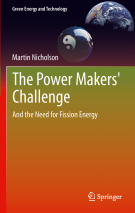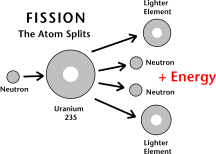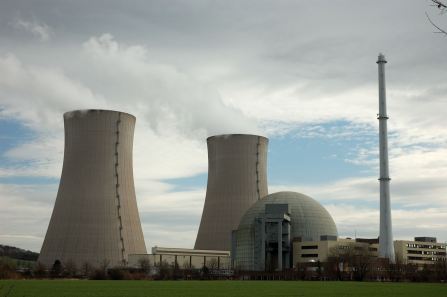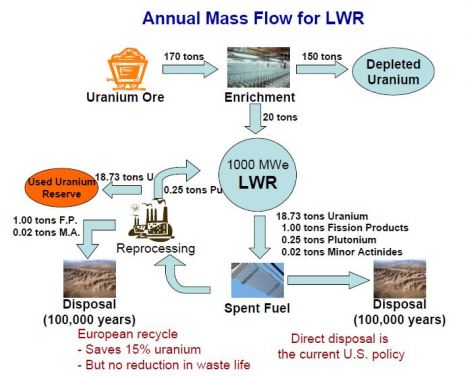 Guest Post by Martin Nicholson. Martin studied mathematics, engineering and electrical sciences at Cambridge University in the UK and graduated with a Masters degree in 1974. He has spent most of his working life as business owner and chief executive of a number of information technology companies in Australia. He has a strong interest in business and public affairs and is a keen observer of the climate change debate and the impact on energy. He is author of Energy in a Changing Climate, as well as an upcoming book on sustainable energy systems, and is the lead author of the 2011 paper in the journal Energy “How carbon pricing changes the relative competitiveness of low-carbon baseload generating technologies“. He wrote a popular post last year on BNC entitled: Cutting Australia’s carbon abatement costs with nuclear power
Guest Post by Martin Nicholson. Martin studied mathematics, engineering and electrical sciences at Cambridge University in the UK and graduated with a Masters degree in 1974. He has spent most of his working life as business owner and chief executive of a number of information technology companies in Australia. He has a strong interest in business and public affairs and is a keen observer of the climate change debate and the impact on energy. He is author of Energy in a Changing Climate, as well as an upcoming book on sustainable energy systems, and is the lead author of the 2011 paper in the journal Energy “How carbon pricing changes the relative competitiveness of low-carbon baseload generating technologies“. He wrote a popular post last year on BNC entitled: Cutting Australia’s carbon abatement costs with nuclear power

This post, and the previous one, provides an insight into Martin’s new book: The Power Makers’ Challenge: and the need for Fission Energy
———————-
PART 2
Fission Energy
The big difference between a coal and fission energy is that coal is combusted (that is, burned in a chemical reaction with oxygen) to boil the water, whereas fission relies on a nuclear reaction by splitting uranium atoms to generate heat.
 Fig. G.2 Fission Energy. From US Energy Information Administration (2008)
Fig. G.2 Fission Energy. From US Energy Information Administration (2008)
The most common type of nuclear fission reactors are thermal reactors called ‘light-water’ reactors (LWR). Thermal reactors were first used commercially to generate electricity in the late 1950s and there are now over 400 thermal reactors installed in more than 30 countries world-wide. Together they generate about 16% of the world’s electricity. France is one of the largest users of fission energy and gets almost 80% of its electricity from its 59 nuclear power stations.
 Fig.G.1 Nuclear Power Plant. From Lange P (2009)
Fig.G.1 Nuclear Power Plant. From Lange P (2009)
Both coal and fission reactor plants use fuels mined from the earth. A big difference is in the amounts of fuel. A 1,000 MW coal power station needs about 3 to 4 million tonnes of coal a year. A 1,000 MW fission reactor plant accounts for only about 150 to 200 tonnes of natural uranium a year. Less fuel used means less fuel to store and less waste. No huge coal storage areas and waste slag heaps containing toxic metals like arsenic and lead are needed for fission reactor plants, and there is no need for thousands of kilometres of coal freight trains.
Fission reactor fuel is significantly less expensive than coal per unit of energy generated. Fuel in a fission plant makes up about 5-10% of the cost of running the plant. For a coal plant that can be 30-60%. Fission energy is 30% cheaper than the least expensive CCS solution and less than half the cost of solar thermal.
 Fig. G.3 Nuclear Fuel Cycles. From Chang Y (2010)
Fig. G.3 Nuclear Fuel Cycles. From Chang Y (2010)
Coal and fission are both improving their efficiency in process technology. However light-water reactors use less than 1% of the energy in the natural uranium while coal plants use closer to 40% of the energy in the coal. Thus there is substantially greater scope for efficiency improvement with fission than fossil fuels. There are no physical impediments to extracting practically all the energy in the natural uranium by recycling the used fuel. Fission energy has the unique advantage of using a fuel with an energy density millions of times greater than any other known energy source.
Fission energy was a massive breakthrough in 1951, yet it has only been exploited to a fraction of its potential. Since those early days of ‘atomic’ energy, as it used to be called, it has steadily expanded despite some heavy setbacks in the 1980s. Unlike other energy sources, it is on the brink of improving its efficiency 100 fold. This is unlikely to be possible for any existing renewable energy resources or fossil fuels. So why do many in the community still resist using it?
Filed under: Emissions, Nuclear | 4 Comments »






.png)





